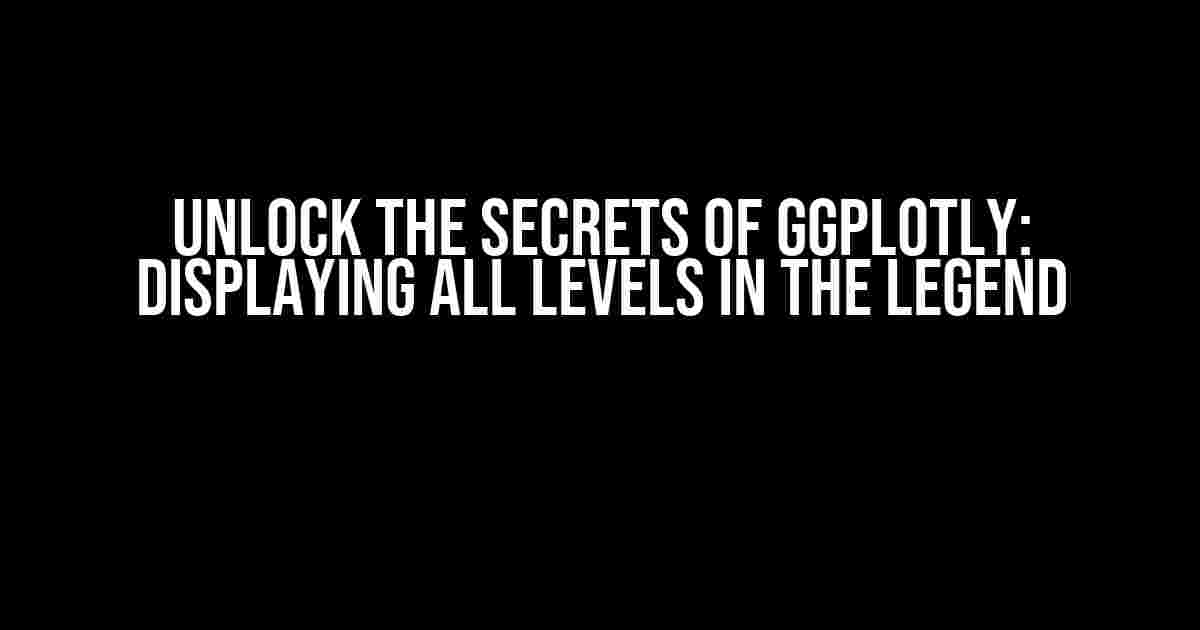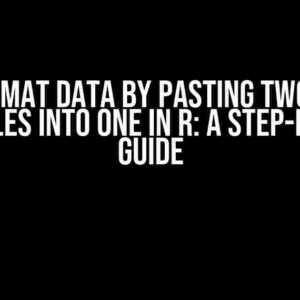Are you tired of dealing with messy legends in your ggplotly visualizations? Do you struggle to display all levels in the legend, only to find yourself lost in a sea of colors and labels? Fear not, dear data enthusiast! This article is here to guide you through the process of showcasing all levels in the legend of your ggplotly object, with ease and elegance.
Understanding the Problem
Before we dive into the solution, let’s take a step back and understand the issue at hand. By default, ggplotly plots often truncate the legend, making it difficult to distinguish between different levels. This is particularly problematic when working with large datasets or intricate visualizations. The good news is that with a few simple tweaks, you can display all levels in the legend, giving your audience a clearer understanding of your data.
The Solution: scales and guides
The key to displaying all levels in the legend lies in the scales and guides functions in ggplotly. Specifically, we’ll focus on the `scale_color_discrete()` and `guides()` functions. These powerful tools allow you to customize your legend, making it more readable and informative.
library(ggplotly) library(dplyr) # Load the iris dataset data(iris) # Create a ggplot object p <- ggplot(iris, aes(x = Sepal.Length, y = Sepal.Width, color = Species)) + geom_point() # Convert to ggplotly ggplotly(p)
In the above example, we create a simple ggplot object using the iris dataset. When we convert this to a ggplotly object, the default legend is truncated, making it difficult to distinguish between the three species.
Method 1: Using scale_color_discrete()
p <- ggplot(iris, aes(x = Sepal.Length, y = Sepal.Width, color = Species)) +
geom_point() +
scale_color_discrete(breaks = c("setosa", "versicolor", "virginica"),
labels = c("Setosa", "Versicolor", "Virginica"))
ggplotly(p)
In this example, we use `scale_color_discrete()` to specify the breaks and labels for each level in the legend. This results in a more informative and readable legend.
Method 2: Using guides()
An alternative approach is to use the `guides()` function to customize the legend. Here's an example:
p <- ggplot(iris, aes(x = Sepal.Length, y = Sepal.Width, color = Species)) + geom_point() + guides(color = guide_legend(override.aes = list(size = 2))) ggplotly(p)
In this case, we use `guides()` to customize the legend, specifying the size of the legend key using `override.aes()`. This results in a more visually appealing legend that showcases all levels.
Additional Tips and Tricks
While the above methods provide a solid foundation for displaying all levels in the legend, there are a few additional tips and tricks to keep in mind:
- Use meaningful labels: Make sure to use descriptive and informative labels for each level in the legend. This will help your audience quickly understand the data.
- Customize colors: Use colors that are easy to distinguish and suitable for your dataset. You can use built-in color palettes or create your own custom palette.
- Adjust legend size: Use `theme()` to adjust the size and position of the legend. This can help improve readability and reduce clutter.
- Interact with the legend: In ggplotly, you can interact with the legend by clicking on the legend items to toggle their visibility. This can be a powerful way to explore and analyze your data.
Common Issues and Solutions
As you work with displaying all levels in the legend, you may encounter some common issues. Here are some solutions to get you back on track:
| Issue | Solution |
|---|---|
| Legend is too cluttered | Use `theme()` to adjust the size and position of the legend, or use `guides()` to customize the legend key. |
| Colors are not distinct | Use a built-in color palette or create a custom palette with distinct colors. |
| Legend is not displaying all levels | Use `scale_color_discrete()` or `guides()` to specify the breaks and labels for each level. |
Conclusion
Displaying all levels in the legend of a ggplotly object is a crucial step in creating informative and engaging visualizations. By using the `scale_color_discrete()` and `guides()` functions, you can customize your legend to showcase all levels and provide a clearer understanding of your data. With these tips and tricks, you'll be well on your way to creating stunning visualizations that tell a story.
Remember, the key to effective data visualization is to make it easy for your audience to understand the data. By displaying all levels in the legend, you're giving your audience a clearer understanding of the insights and patterns in your data. Happy visualizing!
Frequently Asked Question
Are you tired of wondering how to display all levels in the legend of a ggplotly object? Worry no more! We've got you covered with these FAQs.
Why are some levels missing from my ggplotly legend?
This is a common issue that occurs when you're working with a factor variable that has beendropped due to missing values. To fix this, you can use the `drop = FALSE` argument within the `scale_color_discrete()` or `scale_fill_discrete()` function to ensure that all levels are kept, even if they don't have any observations.
How do I display all levels in the legend of my ggplotly object?
To display all levels in the legend, you can use the `guide = "legend"` argument within the `scale_color_discrete()` or `scale_fill_discrete()` function. This will ensure that all levels are shown in the legend, even if they don't have any observations.
What if I want to customize the legend labels and titles?
You can customize the legend labels and titles using the `labels` and `name` arguments within the `scale_color_discrete()` or `scale_fill_discrete()` function. For example, you can use `labels = c("Label 1", "Label 2", ...)` to specify custom labels, and `name = "Legend Title"` to specify a custom legend title.
How do I reorder the legend levels in my ggplotly object?
You can reorder the legend levels using the `breaks` argument within the `scale_color_discrete()` or `scale_fill_discrete()` function. For example, you can use `breaks = c("Level 1", "Level 2", ...)` to specify the order of the levels.
Is it possible to remove the legend title or labels?
Yes, you can remove the legend title or labels using the `element_text()` function from the `ggplot2` package. For example, you can use `theme(legend.title = element_text("'))` to remove the legend title, or `theme(legend.text = element_text("'))` to remove the legend labels.


